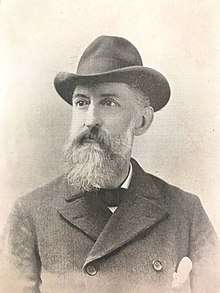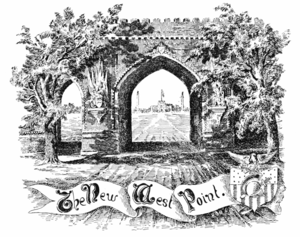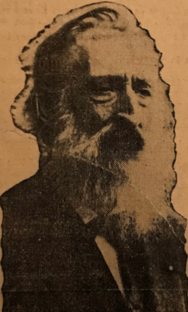William James Roe
William James Roe II (September 1, 1843 - April 3, 1921) was an American author, artist, philosopher and businessman.
William James Roe | |
|---|---|
 | |
| Born | September 1st, 1843 Newburgh, New York |
| Died | April 3, 1921 (aged 77) New Windsor, New York |
| Resting place | St. George's Cemetery (Newburgh, New York) |
| Pen name | Hudor Genone, G. I. Cervus, Viroe |
| Occupation | Writer, artist, clerk |
| Language | English |
| Education | United States Military Academy, West Point, New York |
| Genre | Satire, fiction, science fiction, fantasy |
| Notable works | Cut: A Story of West Point (1885), Inquirendo Island (1886), Bellona's Husband: A Romance (1886), An Inn for Journeying Thoughts (1912) |
| Years active | 1859 - 1920 |
| Spouse | Mary Stuart Norton (m. 1867) |
| Children | 3 |
| Relatives | Edward Payson Roe (first cousin) |
Early life

Roe was born on September 1, 1843 in his grandfather's mansion on Grand Street.[2] He was educated at Russell Military Academy in New Haven, Connecticut, a preparatory school for young men interested in attending nearby Yale or West Point. After abruptly leaving Russell's, Roe was enrolled at the Newburgh Collegiate Institute, a private boys' school in Newburgh administered by Polish-American M. L. Domanski.[3] During this time, he began writing for the school's magazine,The Acorn. [4] At fifteen, Roe left his schooling to study law at the firm Hasbrouck & Taylor in Newburgh. His uncle, William C. Hasbrouck, supervised his studies. Later in life, he remarked that the law profession was not for him.[5]
In 1861, he enlisted in a volunteer company, the 124th New York Volunteer Infantry Regiment, in response to the outbreak of the Civil War. Though he was elected sergeant, his father was opposed to him engaging in the war and took him to Europe in January 1862. Roe Sr. claimed he would allow his son to continue if the war had not ended within six months. Most of those six months were spent abroad, and the Roes visited England, France, Switzerland and Italy. Roe corresponded with the Newburgh Journal, and letters from his travels abroad were serialized. While traveling, cadetship at West Point was offered. Going through West Point to become a lieutenant was more favorable for than fighting. He received an appointment from the Hon. John Sedgwick and began in 1863, graduating in 1867.[6]
Business career
When Roe I was declared a lunatic, his son took the reins on his business ventures and maintained his property. Roe II was appointed overseer of his father's will and finances. William James Roe I died on November 20, 1875. Much of his property and earnings were lost due to financial inexperience.
Seeking to regain the losses, Roe became president of the Hydrogen Company of New York and New Jersey in 1881.[6] He had moved his family to Montclair, New Jersey in 1880. The company sought to perfect a process that made iron parts insusceptible to rust. A building was erected at West 18th Street in Manhattan and more commercial outlets were realized. None of these came to fruition, as the process was never improved to the satisfaction of a market. The company collapsed immediately after this failure.
Writing career
Roe had always found a hobby in writing creatively and for the press. After he regained part of his fortune, he turned to writing entertaining short stories, philosophical works and poetry.
His earliest novels were The Model Wife, White Feathers and Cut: A Story of West Point. At the time of its publication, Cut was regarded as the most accurate depictions of cadet life at West Point, being based heavily on Roe’s own experiences. He soon after began planning new novels under the pen names Hudor Genone and G. I. Cervus.
One of his most popular novels was Inquierendo Island, published in 1886 by G. P. Putnam’s Sons, the Twentieth Century Company and Charles H. Kerr Publishing Company. It aroused much debate over its religious satire elements in the United States and abroad. In Inquierendo Island, he “dramatized in unmistakable terms his negative feelings about Christianity. The protagonist, shipwrecked on the eponymous mid-Atlantic Island, discovers that its inhabitants have constructed a topsy-turvy Religion, which they follow with pious zeal, out of their ancestors' bad memories of their own shipwreck and out of idolatry directed towards the arithmetic text which is the only printed book to have survived; they worship at the church of Saint Complex Fraction. The book can also be seen to mock the triumphalist arguments that bolster the typical Robinsonade.”[7]
About a year later, Bellona’s Husband: A Romance was published by J. B. Lippincott & Co.. The novel “takes its protagonists via Spaceship – powered by a kind of Antigravity device – to Mars, where they find a humanlike society distinguished from ours partly by the Martians' insistence that the literal truth must always be told, but mainly by the fact that they live backwards in time, growing constantly younger; this may be the earliest example of the Time in Reverse tale presented in full-fledged narrative form.”[8]
In 1892, The Last Tenet Imposed upon the Khan of Thomathoz was published by Charles H. Kerr & Company. Roe's affinity for religious satire continued. The novel describes “the discovery by sixteenth-century missionaries of the Lost World of Thomathoz hidden in the mountains of Asia.”[8]
More compact works such as such as John Morton’s Morals and Scarlet Gods were novels both published serially in Town & Country, while the esoteric and slightly occult “The Philosophy of a Divine Man” was published in The Metaphysical Magazine. For a brief period, Roe had an interest in the occult, becoming interested in hypnotism and divination. He later found these to be dangerous, denouncing[9] Eusapia Palladino in The New York Times.
Personal life
On July 1, 1867, Roe married Mary Stuart Norton at Central Presbyterian Church in Buffalo, New York.
Roe was raised Episcopalian at St. George's Church, Newburgh, despite many of his ancestors being Presbyterian. He was integral to the founding of the first Reformed Episcopal church in Newburgh, which he had selected the name for: The Church of the Corner-Stone.[10]

Roe had three children: William James III, Anna Lawrence,[11] called "Nan" or "Annie" by the family, and Mary Stuart.[12]
Mary Stuart went on to marry the artist Lee Woodward Zeigler on October 16, 1909,[13] at St. Thomas Episcopal Church.[14][15] Both daughters were talented writers, and often wrote using pen names in St. Nicholas Magazine.
On November 27, 1920, the family was traveling to the 1920 Army-Navy Football Game at the Polo Grounds in New York City when Anna was killed in an automobile accident.
Roe never recovered from her sudden death. That winter, he began to lose interest in life and his writing. He passed away on April 3 at 77.[16] He requested that his funeral not exceed $250 in costs. It was held on the afternoon of April 5, after which he was buried in St. George's Cemetery.
References
- Popular Science Monthly Volume 64 November 1903.
- Roe, William James (1914). Reminisces and Anecdotes of the Roe Family.
- "Newburg Collegiate Institute". The New York Times. 21 October 1858. p. 3.
- Corning, A. Elwood (22 June 1946). "Historical Notes". The Beacon News. Beacon, New York. p. 4.
- "William James Roe". Newburgh News. September 14, 1914.
- "Annual Report of the Association of the Graduates of the United States Military Academy". June 12, 1922: 122–129. Cite journal requires
|journal=(help) - "Authors : Genone, Hudor : SFE : Science Fiction Encyclopedia". www.sf-encyclopedia.com. Retrieved 2020-01-15.
- "Hudor Genone". The Encyclopedia of Science Fiction. The Encyclopedia of Science Fiction Editors.
- Roe, William James (18 May 1910). "If Palladino Wins Her Case". The New York Times.
- Nutt, John J. (1891). Newburgh: Her Institutions, Industries and Leading Citizens. Richie & Hull. p. 147.
- "Anna Lawrence "Nan" Roe". Find A Grave.
- "Mary Stuart Roe Zeigler". Find A Grave.
- "New York, County Marriages, 1847-1848; 1908-1936," database with images, FamilySearch (https://familysearch.org/ark:/61903/3:1:9Q97-YSGQ-TFK?cc=1618491&wc=38MT-16D%3A1583148802%2C1583192901 : 18 March 2019), Orange > Marriage records, 1908-1913, vol 1 > image 140 of 525; citing county clerk offices from various counties, New York.
- "Mr. William J. Roe has sent out cards announcing the marriage of his daughter". The Washington Post. 21 October 1909.
- "Lee Woodward Zeigler". Find A Grave.
- "Obituaries". New York Times. April 4, 1921.